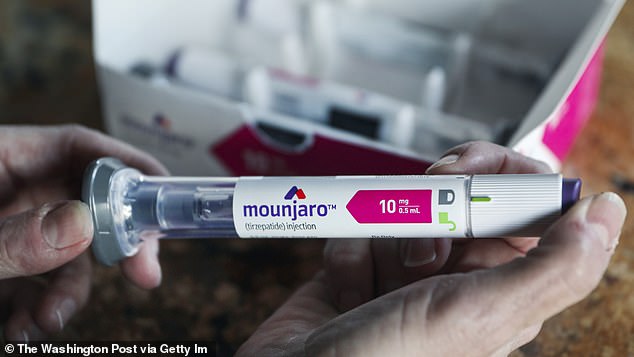Weight loss injections have taken medicine by storm and are giving many people real hope for safe and effective weight loss.
After years of doctors being unable to offer patients little more than advice on diet and exercise, it seems we may finally have a solution to the obesity crisis.
And not a moment too soon: according to the latest NHS statistics, most people in England are now overweight or obese, with almost two thirds of adults and 30 per cent of children ‘too heavy’. It is estimated that obesity costs the country £58 billion a year. To put that into perspective, that’s just under a third of the entire NHS budget.
If we can get on top of obesity, imagine what it will do not only to people’s lives but also to the economy and the sustainability of our NHS.
Now another new drug has been approved for weight loss in the UK: Mounjaro. And I predict this will be even bigger than Wegovy.

Mounjaro is a medicine called tirzepatid and has been used to treat diabetes
Just to be clear, Wegovy and Ozempic are the exact same medication – both are the drug semaglutide. Wegovy is licensed for use in weight loss, while Ozempic is licensed for use in diabetes.
Mounjaro is different: it is a drug called tirzepatid. Like Wegovy, it has been used in the past to treat diabetes, but also causes weight loss.
While Wegovy works on one receptor (the GLP-1 receptor), Mounjaro works on two – the GLP-1 receptor and the GIP receptor.
Both of these receptors are involved in stabilizing blood sugar levels, helping patients feel fuller for longer and reducing cravings.
By working on two different receptors, the weight loss effects are thought to be enhanced. This is confirmed by research.
While studies in Wegovy have shown up to 15 percent weight loss after one year, Mounjaro has shown 20 percent—and some people even achieved 25 percent weight loss.
There was concern that the side effects — some people suffer from nausea, diarrhea, vomiting or constipation — from targeting two receptors might be worse than for Wegovy, but that doesn’t appear to be the case.
So Wegovy or Mounjaro? Firstly, it is important to say that if you choose one of them, you will probably have to go private (it is very difficult to get these drugs on the NHS) and, depending on the dose, they can cost more than £200 a month.
If you still think it’s for you, then it’s really a matter of personal choice.
As with all medications, everyone is different and some people find that they respond better to one than the other.


Dr. Max says: I believe that, provided they are prescribed carefully, these weight loss drugs could revolutionize the way we tackle obesity
If you’re on Wegovy and it’s working for you, there’s no reason to switch. This drug has been around longer than Mounjaro, so there has been more research on it – and some people will find it somewhat reassuring.
However, there are still significant supply issues with Wegovy, with stocks limited globally.
Unfortunately, I have heard of a number of patients who have started treatment but then struggled to get subsequent supplies and either had to stop or shop around to find stock.
As a result, some people even ended up buying fake Wegovy from dubious suppliers.
Both Mounjaro and Wegovy are started at low doses and then gradually increased to a ‘maintenance dose’.
Wegovy has one maintenance dose (2.4 mg), although it is possible to remain at lower doses if clinically indicated.
Mounjaro, on the other hand, has three maintenance doses (5mg, 10mg and 15mg). This means that there can be more flexibility in choosing the dose if you want to take things slowly or are susceptible to side effects.
While both Mounjaro and Wegovy come in pre-filled pens with four doses, one to be injected every week, after seeing both pens myself, I’d say Wegovy is a little easier to use.
The display is easier to see and it only needs to be ‘primed’ (air expelled) once.
However, with Mounjaro you have to remember to do this every time you use it.
I believe that, provided they are prescribed carefully, these medications can revolutionize the way we tackle obesity.
There is no doubt that over the coming years many more drugs will be developed to help those struggling to lose weight. And the more options there are for patients, the better.
Under their new contract, GPs must allow patients to book appointments over the phone rather than insist they book online. It follows a campaign by older people’s rights group Silver Voices to ensure the NHS is not just for the tech-savvy.
Gwynnie’s recipe for a happy family
‘Blended’ families – those where the parents have children from other relationships but still form one family unit – are now very common. In the UK, one in three families is ‘mixed’.
But it’s not always easy to form one, as Gwyneth Paltrow acknowledged last week.
The actress, 51, said it was “tough” to be stepmother to husband Brad Falchuk’s children from his first marriage – Isabella, 19, and Brody, 17. She also shares Apple, 19, and Moses, 17, with her ex, Chris Martin.


Gwyneth Paltrow acknowledged that creating a blended family isn’t always easy
Gwyneth said she had a ‘difficult relationship at first’ with Brody and Isabella, but ‘now they’re like my children’, adding: ‘You have to embody the spirit of the sun and just give and not expect anything in return… Keep it up shine. ‘
I don’t always have much time for hippy-dippy Gwyneth, but she’s right. The key to success is to be consistent in your love, even when none is returned. If you can get it right, a blended family just becomes a family.
One in ten of the 4,017 13 to 16-year-olds polled for BBC Bitesize said they would most like to be a doctor. The NHS was the employer of choice with Apple in second place. I really hope this is true as I have often worried that the technology boom is taking our brightest minds away from medicine.
We urgently need more home-grown health professionals. Yes, being a doctor is stressful, but I really love it. It is stimulating, fascinating and rewarding. Knowing that you are spending years of study helping others gives you a job satisfaction that is hard to describe.
Dr. Max prescribes… Plant a tree
The best time to plant a tree was 20 years ago. The next best time is now. A survey of 255 GPs for the Woodland Trust found that 74 per cent believed that planting trees to create a healthy environment could reduce the financial burden on the NHS. Learn how at woodlandtrust.org.uk.

